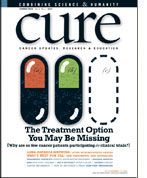Publication
Article
CURE
Watching, Waiting, & More
Author(s):
Helen Anbinder of Dobbs Ferry, New York, achieved a lot—and much was achieved on her behalf—in the seven years between her CLL diagnosis and treatment.
Helen Anbinder of Dobbs Ferry, New York, achieved a lot—and much was achieved on her behalf—in the seven years between her chronic lymphocytic leukemia diagnosis and treatment.
Anbinder, now 68, learned in 2001 that she had early-stage CLL. She consulted a specialist—Kanti R. Rai, MD, at Long Island Jewish Medical Center in New Hyde Park, New York (the Rai staging system for CLL bears his name)—and because she didn’t need treatment yet, was cared for with a “watch and wait” approach.
But that doesn’t mean Anbinder sat still. Having sought information about her disease from the Leukemia & Lymphoma Society (LLS)—and having heard of the remarkable success of the drug Gleevec (imatinib) for another type of leukemia, chronic myeloid leukemia—she had a ready answer months later when her brother- and sister-in-law, Stephen and Madeline Anbinder of New York City, wanted to make a charitable gift of more than $200,000 in her honor.
“Without hesitation I said I wanted it to go for CLL research,” says Helen, a retired administrator of a local continuing education program. “News had come out about Gleevec, but I could see nothing of that nature in the pipeline for CLL.”
She met with the LLS and decided to earmark the money for research by The Ohio State University’s John Byrd, MD, and colleagues, who were testing a new CLL treatment protocol combining Fludara (fludarabine) and Rituxan (rituximab) (FR).
In 2004, Helen Anbinder formed a family-and-friends team for the society’s Light The Night Walk, raising $6,100. By the time her CLL needed treatment in 2008, Anbinder’s team had racked up more than $67,000 in the annual events. She also began volunteering in the LLS’s Westchester/Hudson Valley chapter office—she now serves on its board—and in 2005 appeared in a national video highlighting the society’s work.
As it turns out, the treatment Rai finally recommended for her was the very protocol Byrd was testing. Three cycles of FR and Anbinder was in remission. “It actually worked too well,” she says—her white cell count plummeted after the first round and she was hospitalized for a respiratory infection. Subsequent cycles were shortened from five days to four.
Like Energizer bunnies, the Anbinder clan has kept going. Their fund-raising team’s total now exceeds $111,000. Anbinder helps with LLS donor development and supports newly diagnosed patients through the society’s First Connections program. Her younger son, Jeff, bicycles to raise money for LLS. And her in-laws continue to contribute annually to CLL research.
Although Anbinder reports her white cell count is climbing again, she continues her many travels abroad with her husband, Paul. At some point she expects to need more treatment—very possibly, she says, that same treatment that worked so well for her before.






